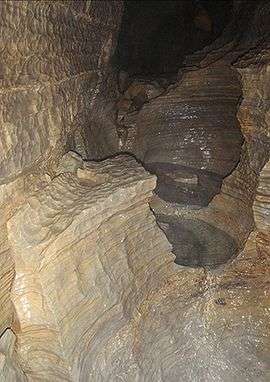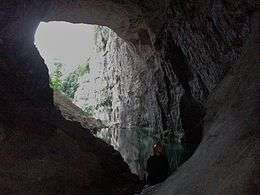Vercors Cave System
The Vercors cave "system" is an Anglophone way of referring to the many long, narrow caves situated in the Vercors Massif, in South-Eastern France. The caves include the Bournillon cave, which has the highest cave entrance in Europe.[1]

Location
The caves are located in the limestone area in the Rhône-Alpes region, in the lower Alps.[1]
History
The caves are well known to British explorers, since the expedition led by Ken Pierce in the early 1960s introduced them to the area.[2]
Description

The total area with the caves extends to around 400 square miles (1000 square kilometres) with a depth of up to 1271 metres (4170 feet). The surrounding area around the caves is the largest karst area in Europe. The caves are formed because of the Cretaceous limestone throughout the caves, that is up to 400 metres (1300 feet) thick at some points.[1]
The caves passages are a mix of large, old and dry tunnels, full of calcite deposits with narrow streamways and waterfalls.[1]
There are specific sets of caves because of the geology of the area, each with their own characteristics. In the north east (from the Moucherolle up to the Sornin Plateaux) the caves are regarded as very deep and very demanding in the grading system, especially considering the variable weather in the area. In the north west of the system, the caves (including the Autrans and Meaudre systems) are of current interest, as many new caving discoveries are being made, particularly in the Meaudre area, on a regular basis. Further south the caves vary in their characteristics, with systems in the Herbouilly Plateau being of different gradings. The area surrounding the Vernaison and its associated river valley contains many caves and systems, with one of the most explored being the Grotte de la Luire just south of Saint-Agnan-en-Vercors which is located at the Bournillon entrance, which is the largest cave entrance in Europe.[1][2]
Probably the most famous and deepest cave in the region is the Gouffre Berger cave. This cave includes the narrow shafts, descending into the Grand Galerie, which itself is home to very large and very old stalagmites. This particular system follows the slope of the limestone beds for 3 kilometres (1.9 mi), until it meets the flooded area of the Cuves de Sassenage.[1][3]
Skeleton of Boy
On 23 May 1985, the skeleton of a young boy was found in the caves. Originally, he was believed to be the body of Ludovic Janvier, a boy who disappeared from Grenoble on 17 March 1983. Despite pleas from his family, especially his mother, his DNA has never been tested and he has yet to be identified. Ludovic has also never been found. [4][5]
References
- Liz Wheeler, ed. (2003). Earth. p. 256. ISBN 1-4053-0018-3.
- "Description of the cave system". 2002. Retrieved 2009-11-04.
- "Les Cuves se Sassenage" (pdf). parc-du-vercors.fr..
- "Disparus de l'Isère", Wikipedia, 2018-12-29, retrieved 2019-04-17
- "Disappearance of Ludovic Janvier", Wikipedia, 2019-04-06, retrieved 2019-04-17
See also
- Vercors Plateau
- Caves
- "Vercors Caves". on google.com/maps.